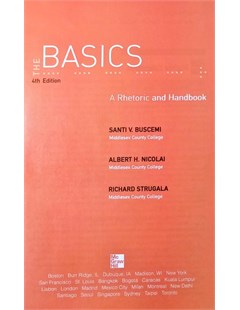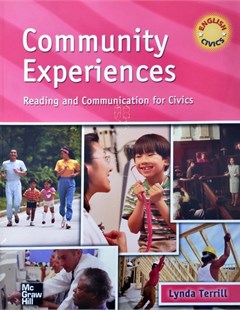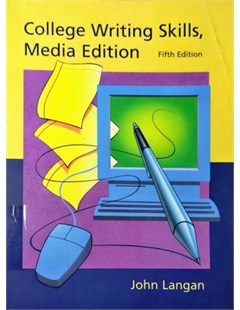The Basics: A Rhetoric and Handbook with Catalyst Access Card
Includes coverage of the writing process, as well as material on critical reading and argument, oral presentations and essay exams, online design and working with computers, and coverage of grammar and usage.
2005
This book includes exercises, a reference system, a spiral-binding and tabs, and explanations of grammar and usage. A clear, non-technical discussion of grammar and outstanding coverage of the writing process make The Basics a complete brief rhetoric as well as an exceptional reference tool. One of the few brief handbooks with integrated exercises, The Basics helps students successfully transfer what they learn to their own writing.
Indicates material new to this edition
+ Tab 1: Reading, Writing, Arguing 1. * Reading Critically 2. Prewriting 3. Outlining and Drafting an Essay 4. Developing Paragraphs for the Introduction, Body, and Conclusion of an Essay 5. Revising, Editing, and Proofreading 6. Developing Arguments *
+ Tab 2: Online Writing and Electronic Design 7. * Using Computers in College 8. * Writing Online 9. Designing with Computers
+ Tab 3: The Research Process 10. Creating a Research Strategy 11. Researching and Evaluating Traditional Sources 12. Researching and Evaluating Electronic Sources 13. Taking Notes and Avoiding Plagiarism 14. Writing the Research Paper
+ Tab 4: MLA Documentation 15. Writing the Research Paper Using the Modern Language Association (MLA) Format
+ Tab 5: APA Documentation 16. Writing the Research Paper Using the American Psychological Association (APA) Format
+ Tab 6: CMS Documentation 17. Writing the Research Paper Using The Chicago Manual of Style (CMS) Format
+ Tab 7: Special Writing Situations 18. Writing About Literature 19. * Communicating in Class: Essay Examinations and Oral Presentations 20. Communicating in Business
+ Tab 8: Sentence Style 21. Learn Sentences, Clauses, and Phrases 22. Master Sentence Structure 23. Combine Sentences Through Coordination and Subordination 24. Maintain Parallelism 25. Use Modifiers That Make Sense 26. Correct Mixed Constructions and Faulty Shifts 27. Create Interest by Varying Sentence Patterns 28. Write in a Clear and Emphatic Style
+ Tab 9: Word Choice 29. Use a Dictionary and a Thesaurus 30. Use Exact Language 31. Maintain Appropriate Tone, Style, and Word Choice 32. Make Your Writing Concise
+ Tab 10: Grammar 33. Learn Parts of Speech 34. Master Verb Forms and Tenses 35. Maintain Subject-Verb Agreement 36. Learn Pronoun Types, Cases, and Reference 37. Maintain Pronoun-Antecedent Agreement 39. Use Adjectives and Adverbs Correctly
+ Tab 11: Punctuation, Spelling, and Mechanics 39. Master End Punctuation 40. Master the Comma 41. Master the Semicolon 42. Master the Colon 43. Master the Apostrophe 44. Master Quotation Marks 45. Master Other Marks of Punctuation 46. Improve Your Spelling 47. Use the Hyphen 48. Master the Rules of Capitalization 49. Learn to Abbreviate Words, Phrases, and Titles 50. Use Numbers and Italics Correctly
+ Tab 12: ESL Guide 51. Master Articles and Plurals of Nouns 52. Master Sentence Structure 53. Master Verbs and Subject-Verb Agreement 54. Use Adjectives, Participles, and Adverbs Correctly 55. Use Words Correctly Index Correction Symbols for Common Problems
Santi V. Buscemi, Albert H. Nicolai, Richard Strugala, The Basics: A Rhetoric and Handbook with Catalyst Access Card, Mc. Graw Hill, 2005.
 |  |  |
The Basics: A Rhetoric and Handbook with Catalyst Access Card | Community experiences: Reading and communication for civics | College Writing Skills, Media Edition |
Thứ Sáu, 09:30 24/02/2023
Copyright © 2018 Hanoi University of Industry.